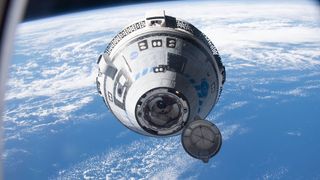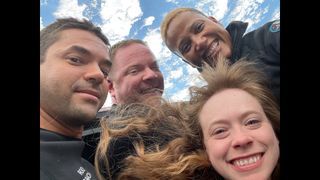Boeing's Starliner spacecraft will not fly private missions yet, officials say
"We've got plenty of time to think about what's after."

Boeing says it may sign up private astronauts for future Starliner missions, but the focus is on NASA for now.
The spacecraft's program manager, Mark Nappi, told reporters Thursday (April 25) the company is very focused on flying the first Starliner mission for NASA with astronauts on board. That mission, Crew Flight Test (CFT), will see NASA astronauts Butch Wilmore and Suni Williams rocket to space aboard a United Launch Alliance Atlas V rocket no earlier than May 6.
"It [CFT] really is all of our attention at this point," Nappi said during a telephone press conference from the launch area at NASA's Kennedy Space Center near Orlando. After that, Boeing will make sure it has enough spacecraft manufactured for future NASA astronaut flights, which are expected to run to six or seven.
Private flights are a possibility, but not the concern for now given they are building out NASA flights through the International Space Station's possible retirement in 2030, he added. "We've got plenty of time to think about what's after that," Nappi added.
Boeing's decision stands in contrast to the other private company that sends astronauts up to the ISS: SpaceX.
Three years after the space shuttle's retirement in 2011, both SpaceX and Boeing received contracts from NASA to send commercial crew missions to the ISS. As of 2014, when the contracts were announced, Boeing's commercial crew contract for Starliner is valued at $4.2 billion, compared to SpaceX's $2.6 billion.
Get the Space.com Newsletter
Breaking space news, the latest updates on rocket launches, skywatching events and more!
SpaceX sent its first test mission to the ISS in 2020 and has provided 11 more astronaut flights to the complex since: Eight half-year missions for NASA, and three approximately two-week missions for private astronaut company Axiom Space.
Axiom is in fact just one private entity that uses SpaceX's Crew Dragon spacecraft. In 2021, for example, Shift4 billionaire and private pilot Jared Isaacman flew to Earth orbit with three civilians on a mission known as Inspiration4. Isaacman next bought three more Crew Dragon missions for a three-mission private series known as the Polaris Program. The first of the trio, Polaris Dawn, may fly with Isaacman and three other people as soon as this year and feature the first commercial spacecraft.

Despite all of these private missions flown with SpaceX, Boeing officials have said they are struggling to find a business case for private astronaut missions as the market is so young and uncertain. Private astronaut missions are "just not at a level of maturity where I can write them into any kind of a business case and say that yeah, this is something that's going to kind of get us over the hump," John Shannon, vice president of Boeing Exploration Systems, told the Washington Post in October.
Aside from that, numerous technical problems with Starliner since 2019 forced Boeing to absorb $1.4 billion in unanticipated costs.
Starliner's issues delayed CFT by four years. The spacecraft's first uncrewed flight to the ISS in 2019 failed to reach its destination. Dozens of fixes later, a second test flight without astronauts safely docked with the ISS in 2022. CFT was delayed further in 2023 after critical issues with the parachutes, along with flammable P213 tape in the spacecraft, was discovered.
Steve Stich, program manager for NASA's Commercial Crew Program, told reporters during the same Thursday teleconference that he was impressed at Boeing's methodical fixes to the issues.
"The entire NASA, Boeing and United Launch Alliance team and all the contractors have done a tremendous job working through a myriad of problems getting the certification done, and getting us to this point today," Stich said.
Wilmore and Williams, both former U.S. Navy test pilots, arrived yesterday at KSC to continue their quarantine and preparation for CFT's launch. They aim to do a thorough shakedown of the spacecraft and all systems, including considerable manual flying and testing emergency procedures such as powering up the solar panels, to help certify Starliner for six-month missions.
If CFT's flight goes to plan, the first operational mission (Starliner-1) will fly in early 2025 at the earliest, for a six-month tenure. That crew includes NASA's Mike Fincke, NASA's Scott Tingle and the Canadian Space Agency's Joshua Kutryk.
Join our Space Forums to keep talking space on the latest missions, night sky and more! And if you have a news tip, correction or comment, let us know at: community@space.com.

Elizabeth Howell (she/her), Ph.D., is a staff writer in the spaceflight channel since 2022 covering diversity, education and gaming as well. She was contributing writer for Space.com for 10 years before joining full-time. Elizabeth's reporting includes multiple exclusives with the White House and Office of the Vice-President of the United States, an exclusive conversation with aspiring space tourist (and NSYNC bassist) Lance Bass, speaking several times with the International Space Station, witnessing five human spaceflight launches on two continents, flying parabolic, working inside a spacesuit, and participating in a simulated Mars mission. Her latest book, "Why Am I Taller?", is co-written with astronaut Dave Williams. Elizabeth holds a Ph.D. and M.Sc. in Space Studies from the University of North Dakota, a Bachelor of Journalism from Canada's Carleton University and a Bachelor of History from Canada's Athabasca University. Elizabeth is also a post-secondary instructor in communications and science at several institutions since 2015; her experience includes developing and teaching an astronomy course at Canada's Algonquin College (with Indigenous content as well) to more than 1,000 students since 2020. Elizabeth first got interested in space after watching the movie Apollo 13 in 1996, and still wants to be an astronaut someday. Mastodon: https://qoto.org/@howellspace
-
Ryan F. Mercer Can you imagine if we were still waiting on Starliner and the only way to ISS was still Russia? I don't want to give Musk too much credit, so I'll just dunk on Boeing instead.Reply -
judezee Considering Boeing can't get their grip on commerical air travel, I wouldn't step foot into anything they built for space travel.Reply
